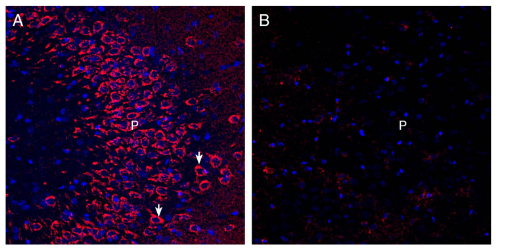Overview
- Peptide (C)RGLQDAGPRRDTMAD, corresponding to amino acid residues 162 - 176 of mouse NPTXR (Accession Q99J85). Extracellular, C-terminus

 Western blot analysis of mouse brain lysate (lanes 1 and 3) and rat brain lysate (lanes 2 and 4):1-2. Anti-Neuronal Pentraxin Receptor (NPTXR)(extracellular) Antibody (#ANR-193), (1:400).
Western blot analysis of mouse brain lysate (lanes 1 and 3) and rat brain lysate (lanes 2 and 4):1-2. Anti-Neuronal Pentraxin Receptor (NPTXR)(extracellular) Antibody (#ANR-193), (1:400).
3-4. Anti-Neuronal Pentraxin Receptor (NPTXR)(extracellular) Antibody, preincubated with Neuronal Pentraxin Receptor (NPTXR)(extracellular) Blocking Peptide (BLP-NR193). Western blot analysis of human SH-SY5Y neuroblastoma cell line lysate (lanes 1 and 3) and human Jurkat T-cell leukemia cell line lysate (lanes 2 and 4):1-2. Anti-Neuronal Pentraxin Receptor (NPTXR)(extracellular) Antibody (#ANR-193), (1:400).
Western blot analysis of human SH-SY5Y neuroblastoma cell line lysate (lanes 1 and 3) and human Jurkat T-cell leukemia cell line lysate (lanes 2 and 4):1-2. Anti-Neuronal Pentraxin Receptor (NPTXR)(extracellular) Antibody (#ANR-193), (1:400).
3-4. Anti-Neuronal Pentraxin Receptor (NPTXR)(extracellular) Antibody, preincubated with Neuronal Pentraxin Receptor (NPTXR)(extracellular) Blocking Peptide (BLP-NR193).
 Expression of Neuronal Pentraxin Receptor in rat hippocampus.Immunohistochemical staining of perfusion-fixed frozen rat brain sections with Anti-Neuronal Pentraxin Receptor (NPTXR)(extracellular) Antibody (#ANR-193), (1:1200), followed by donkey anti-rabbit-biotin and streptavidin-Cy3. A. Staining in the rat hippocampal CA3 region, showed NPTXR immunoreactivity (red) in neuronal profiles (arrows) in the pyramidal layer (P). B. Pre-incubation of the antibody with Neuronal Pentraxin Receptor (NPTXR)(extracellular) Blocking Peptide (BLP-NR193), suppressed staining. Cell nuclei are stained with DAPI (blue).
Expression of Neuronal Pentraxin Receptor in rat hippocampus.Immunohistochemical staining of perfusion-fixed frozen rat brain sections with Anti-Neuronal Pentraxin Receptor (NPTXR)(extracellular) Antibody (#ANR-193), (1:1200), followed by donkey anti-rabbit-biotin and streptavidin-Cy3. A. Staining in the rat hippocampal CA3 region, showed NPTXR immunoreactivity (red) in neuronal profiles (arrows) in the pyramidal layer (P). B. Pre-incubation of the antibody with Neuronal Pentraxin Receptor (NPTXR)(extracellular) Blocking Peptide (BLP-NR193), suppressed staining. Cell nuclei are stained with DAPI (blue).
 Cell surface detection of Neuronal Pentraxin Receptor by indirect flow cytometry in live intact human THP-1 monocytic leukemia cell line:___ Cells.
Cell surface detection of Neuronal Pentraxin Receptor by indirect flow cytometry in live intact human THP-1 monocytic leukemia cell line:___ Cells.
___ Cells + goat-anti-rabbit-FITC.
___ Cells + Anti-Neuronal Pentraxin Receptor (NPTXR)(extracellular) Antibody (#ANR-193), (5μg) + goat-anti-rabbit-FITC.
- Lee, S-J. et al (2017) J Neurosci, 32, 1067.
- Lim et al (2019), Clin Chem Lab Med., 57, 1875.
- Kanda, M. et al (2020), Molec. Cancer, 19, 131.
Neuronal Pentraxin Receptor (NPTXR) belongs to the Pentraxin superfamily of proteins (NP) that is characterized by a pentraxin domain at the C-terminal end. It is the only pentraxin family member anchored to the cell membrane by a putative N-terminal transmembrane domain, as opposed to the other two family members, Neuronal Pentraxin1 (NP1) and Neuronal Pentraxin 2 (NP2) that are secreted proteins. NPs can form homo pentamers and hetero pentamers via their pentraxin domains 1.
NPTXR was first identified as the receptor for the snake venom toxin taipoxin and was later found to bind to AMPARs at excitatory synapses and play important, roles in the activity-dependent regulation of neural circuits via this binding activity 1.
Lately, the levels of NPTXR protein in cerebrospinal fluid has been identified as a novel potential biomarker of Alzheimer’s disease progression and could have important utility in assessing treatment success in clinical trials 2. In addition, NPTXR was identified as a molecule required for gastric cancer metastasis 3.
Application key:
Species reactivity key:
Anti-Neuronal Pentraxin Receptor (NPTXR)(extracellular) Antibody (#ANR-193) is a highly specific antibody directed against an extracellular epitope of the mouse NPTXR. The antibody can be used in western blot and immunohistochemistry. It has been designed to recognize NPTXR from mouse, rat and human samples.
